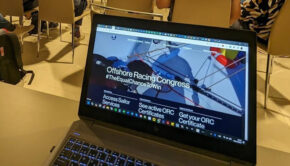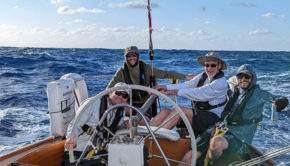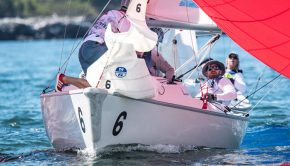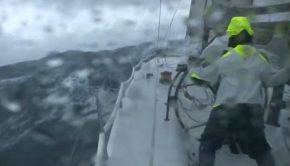Thoughts on Safety-at-Sea
Published on April 8th, 2019
Richard du Moulin is Past Commodore of Storm Trysail Club, serves as chairman of the Storm Trysail Foundation’s Hands-on Safety-at-Sea Seminar and on the US Sailing Offshore Committee. In this report, Rich highlights what to focus on in 2019.
The offshore season in northern waters is about to begin: Annapolis to Newport, Marion to Bermuda, Transatlantic and even our Block Island Race. While the snow is still on the ground, I encourage you to read the report on the death of crew Jon Santarelli of the TP52 Imedi in the 2018 Chicago-Mackinac Race.
It is a sad story with lessons for all of us: click here.
Before heading out of the harbor, Imedi practiced one man overboard (MOB) drill under engine using a floating hat and boat hook. Less than an hour after the start, she was beating to windward in 25 knots of breeze with a 4-8 foot chop. Imedi did not have a reefable mainsail and was flying its #4 jib. Jon was not tethered.
Stationed on the wide deck aft of the helm, he lost balance and slipped under the stern lifelines. Jon’s inflatable PFD did not inflate. It appears he did not try to manual inflate it, or open up the zipper to access the mouth tube. He was initially observed, however, calmly floating on his back with his foul weather gear full of air. Flotation was not thrown until the second attempted pickup.
During the ensuing maneuvers, the Pointer (spotter) did an excellent job never losing sight of the MOB. However, the rest of the evolution was problematic as detailed in the report. The jib sheet was released permitting the jib to wrap around the headstay before it could be dropped.
To make maneuvering more difficult, the unreefed main proved to be a handful. Imedi made three approaches and could not retrieve the MOB before he slipped under. Nearby yachts stood by but couldn’t go in while Imedi was maneuvering.
It is not appropriate to comment in detail but there are a few dramatic and important general take-aways for us all to consider:
Practice! Practice! Practice!
Many Storm Trysail Club volunteers have coached juniors and adults at our Safety-at-Sea (SAS) seminars. STC is unique in that we are the only SAS organizer that gets EVERY student on the water to practice MOB. During the 90 minutes allocated at the adult seminar at the SUNY Maritime College, the crews learn how to do a simple upwind Quick-Stop MOB rescue. This introductory experience primarily serves to expose them to the challenges and convince them of the importance of practice with their own crew on their own boat.
At our junior Safety-at-Sea seminars where the kids go on the water for 3-4 hours, they actually achieve a higher level of skill! Twenty years ago one of these junior crews rescued an MOB (Button Padin’s daughter Lizzie) on the local junior overnight race, and won the Hanson Safety Award by U.S. Sailing.
In the course of a season, most boats practice tacks, gybes, sets, douses, jib changes, etc. Well what about MOB recovery? There is not enough time at any seminar to fully develop the skills and coordination. It can only be accomplished on your own boat with your crew. We recommend that any crew going offshore practice MOB drills as follows:
a) In Light/Moderate breeze- 4 hours – alongside pickup (tallboy buoy) and Lifesling; upwind Quick-Stop; downwind Quick-Stop; downwind letter box (not Quick-Stop).
b) In Moderate/Heavy breeze (20-25 kts) – 4 hours – alongside and Lifesling; upwind Quick-Stop (luff up to allow hiking crew inboard, then heave to); downwind letter box.
c) At the Mooring/Dock – 2 hours – practice techniques retrieving a real volunteer MOB (PFD and drysuit if cold): ladder, Lifesling, Galerider, and particularly lowering a crew in a bosun chair (climbing harness preferred).
The bosun chair technique may be necessary if the MOB is unconscious, hypothermic, injured or weak. The crew in the chair brings a spare tether to attach to the MOB so the crew on deck can secure the MOB while a Lifesling or direct halyard is rigged. The rescuer may have to bearhug the MOB and get hoisted together. A rescue swimmer PFD with a retrieval ring and tether on the back is perfect to wear in a chair, rather than a clumsy inflatable PFD. A helmet is also a good idea.
For a fully crewed boat, a professionally trained rescue swimmer wearing a rescue swimmer PFD/tether, dry suit, and stubby fins may be the only practical method of retrieving an unconscious, hypothermic or injured MOB who might be just a few yards away, out of reach. Professional racing yachts such as the Volvo often do this; amateurs willing to train and practice extensively might consider it. The decision to deploy a rescue swimmer is a serious one, only made when absolutely necessary and based on the sea state, distance to the MOB and the ability of the boat/crew to hold position.
Wear your PFD and Tether!
In the Imedi MOB incident, Jon Santarelli’s PFD did not inflate. Every sailor should know his/her PFD intimately: orally inflate it once a year to test its ability to hold air; check the CO2 cartridge and actuator; know where the manual pull is located and how it operates; know how the zipper can be opened to access the mouth tube. Inflatable PFDs and the hydrostatic mechanisms do age even with annual maintenance, so consider replacements at some interval.
We do not know why Jon’s PFD failed to inflate, but our own Storm Trysail SAS seminar experience confirms that today’s inflatable PFDs are very reliable. During our in-the-water survival swimming sessions headed by Dan O’Connor during 2017-2018, there was only one total inflation failure out of over 500 swimmers. That PFD was old and not maintained. There were a few inflations that required oral top-offs. Net net, a well-maintained inflatable PFD is essential!
Tethering to a jackline or strong point should prevent an MOB. Using the short tether and inboard points removes the risk of being dragged in the water. Being dragged could be a serious risk on a high speed boat, but for conventional boats it is better being tethered, and rely on the helmsman to quickly slow the boat down.
Wearing the tether even when not hooking on is still a good habit. If you go MOB, the tether helps the crew hold you alongside, and then attach a halyard and pick you up.
Use Your Engine!
Imedi did not use her engine on the first pass (the starter was below). She did on the next two attempts. Your engine is essential in a real MOB to ensure that your first pass is successful. It’s good to practice without the engine, but in real life it must be used.
Of course, keep it in neutral until sheets and other lines are out of the water, and return to neutral if the MOB is near the propeller. The engine not only allows the boat to stop alongside the MOB on the first pass, but also maneuver closer to the MOB as needed.









 We’ll keep your information safe.
We’ll keep your information safe.